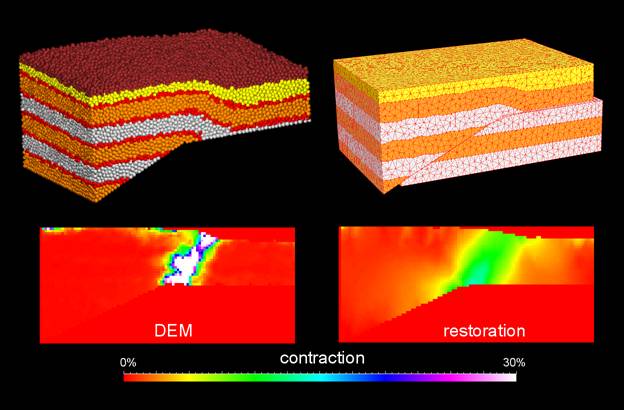Reports: AC8
48385-AC8 New Approaches to 3D Structural Restorations Using Mechanical Constraints for Improved Petroleum Trap and Reservoir Characterizations
We are investigating a fundamentally new approach of performing 3D (volumetric) structural restorations using finite element techniques, in order to develop better methods for characterizing complex petroleum traps and reservoirs. These new methods consider mechanical rock properties in calculating fully 3D restoration displacement and strain fields, and thus offer promise for better defining the geometry and evolution of petroleum traps, as well as constraining patterns of natural fractures and other strain properties in reservoirs that influence oil and gas production.
The new restoration method uses standard finite element approaches to minimizing total strain energy imposed on a model by restoration of a geological datum horizon. In the initial restoration step, the internal and external forces of the model generated by the boundary conditions are calculated using the prescribed elastic constitutive laws and a Lagrangian finite element algorithm. When balanced by the inertia and dampening forces, the total force balance provokes movements of the model nodes. This leads to deformations of each element, where the internal and external forces are again updated using the constitutive relationship. The algorithm iterates this process until it achieves steady state (i.e. a minimum global strain energy), yielding a fully 3D restoration vector field (Figure 1).
Figure 1. Perspective view of the calculated restoration vector field, based on restoration of a shallow growth horizon in the detachment fold model. Green arrows are restoration vectors, and horizons are shown in the deformed state. The upper surface is colored coded by depth.
The elastic constitutive laws employed in the restorations are simple approximations of the naturally complex deformation processes that govern the growth of geologic structures. Thus, in the first year of our study, we sought to rigorously benchmark these new methods by restoring a series of mechanical forward models developed by the discrete element method (DEM). These DEM models generate complex structures similar in many respects to natural systems, yet we know the full displacement, strain, and stress fields for these mechanical models. Applying the restoration methods to these forward models thus gives us an ability to assess quantitatively how well the restoration technique perform in describing complex deformations. These benchmarks also provide insights into the influence of mechanical properties on restoration outcomes.
To facilitate this benchmarking, we generated a series of DEM models of various classes of fault-related folds, which represent common classes of structures in petroleum basin. We then developed computational meshes of these forward models, imposed mechanical properties, and restored these models sequentially. At various stages of restoration, we then compared the displacement fields and strain patterns with those specified by the forward model. We find that by partitioning restoration models into fault-bounded regions, by incorporating flexural slip surfaces, and by summing small increments of deformation that the new method very effectively restores the forward models. This suggests that the 3D structural restoration method may prove useful in defining the deformation history of geological structures, including predictions of strain patterns that may be used to constrain properties such as the distribution of natural fractures.
Figure 2. Comparison of strains from forward DEM model with those calculated by the restoration method. The DEM forward model (upper left) was used to generate a computational mesh (upper right) that was restored using the new method. Strains in the forward model (lower left) are localized along the fold limb, similar to the strain pattern calculated by the restoration (lower right). Strain magnitudes are locally higher in the DEM model due to breaking of particle bonds, a process that cannot be explicitly represented in the finite element-based restorations.
In the second year of our study, we will apply these methods to a series of natural examples, where strain patterns can be compared with borehole fracture observations and dynamic production data to assess the ability of the restoration methods to forecast reservoir properties. We anticipate that these techniques will serve to improve trap and reservoir characterization, leading to optimized drilling and production strategies that will be particularly useful in revitalizing mature fields.






